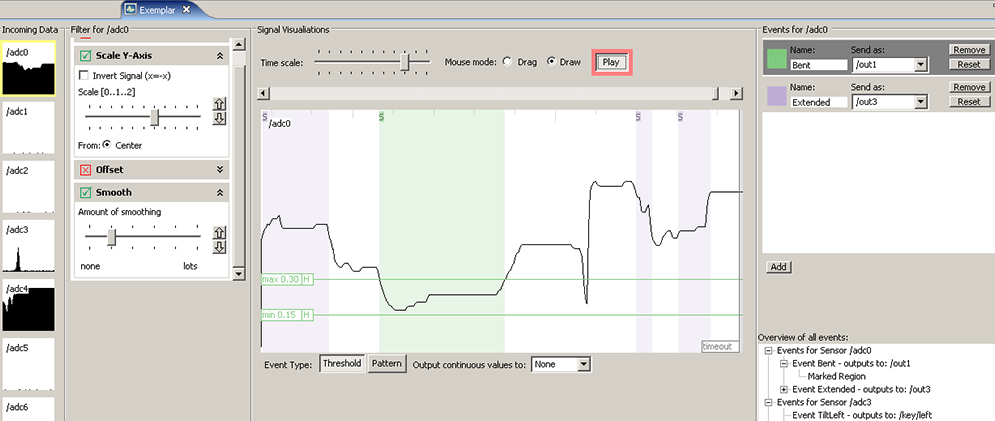Designing Sensor-Based Interactions by Example
From The Theme
HUMAN MACHINE INTERACTION AND SENSING
WHAT IF?
What if we had tools that made designing sensor-based interactions, applications and products as easy as demonstrating sensor input and desired behavior?

WHAT WE SET OUT TO DO
We set out to develop a tool that would make designing sensor-based interactions as easy as performing the actions that the sensor should recognize. Our goal was to enable users to focus on design thinking (how the interaction should work) rather than algorithm tinkering (how the sensor signal processing works).
WHAT WE FOUND
We developed a new authoring system, Exemplar, that combines physical demonstration with interactive machine learning and graphical editing techniques to let designers demonstrate and modify sensor patterns for interaction design.
Users in our research ranked Exemplar highly for decreasing the time required to build prototypes compared to their prior practice. They also ranked the system highly for facilitating rapid modification, for enabling them to experiment more, and for helping them understand the user experience.
LEARN MORE
HCI Stanford, Exemplar Website
Watch Exemplar in Action Video
Hartmann, B., Abdulla, L., Mittal M., Klemmer, S., “Authoring sensor-based interactions by demonstration with direct manipulation and pattern recognition” in CHI ’07 Proceedings of the SGCHI Conference on Human Factors in Computing Systems, ACM New York, NY, USA, 2007 pg 145-154
PEOPLE BEHIND THE PROJECT
 Scott Klemmer is an Associate Professor of Cognitive Science and Computer Science & Engineering at UC San Diego, where he is a co-founder and co-director of the Design Lab. At the time of the project, he served as Associate Professor of Computer Science at Stanford, where he co-directed the HCI Group, held the Bredt Faculty Scholar chair, and was a founding participant in the d.school.
Scott Klemmer is an Associate Professor of Cognitive Science and Computer Science & Engineering at UC San Diego, where he is a co-founder and co-director of the Design Lab. At the time of the project, he served as Associate Professor of Computer Science at Stanford, where he co-directed the HCI Group, held the Bredt Faculty Scholar chair, and was a founding participant in the d.school.
 Bjorn Hartmann is an Associate Professor of Electrical Engineering and Computer Science at the University of California, Berkeley. His research in Human-Computer Interaction focuses on novel design, prototyping, and implementation tools for the era of post-personal computing. Dr. Hartmann received his PhD from the Stanford Computer Science department in 2009.
Bjorn Hartmann is an Associate Professor of Electrical Engineering and Computer Science at the University of California, Berkeley. His research in Human-Computer Interaction focuses on novel design, prototyping, and implementation tools for the era of post-personal computing. Dr. Hartmann received his PhD from the Stanford Computer Science department in 2009.
 Leith Abdulla is building the learning experience team at Coursera. He believes happy healthy teams create solid products, great user interfaces are challenging to build and that a jar of peanut butter is an essential survival tool. Leith received his MA in Computer Engineering from Stanford University in 2007. He likes working with javascript, ios, android, scala and cassandra to impact the world through online education.
Leith Abdulla is building the learning experience team at Coursera. He believes happy healthy teams create solid products, great user interfaces are challenging to build and that a jar of peanut butter is an essential survival tool. Leith received his MA in Computer Engineering from Stanford University in 2007. He likes working with javascript, ios, android, scala and cassandra to impact the world through online education.
 Manas Mittal works on a range of technology projects, including software, hardware and prototyping. He has an SM from MIT Media Lab, a Masters in Computer Science from UC Berkeley, and is working towards his PhD in Computer Science at UC Berkeley. At the time of this project, Manas was a Visiting Scholar at Stanford University with the research question – How can we make it easier for people to prototype physical computing devices with sensors?
Manas Mittal works on a range of technology projects, including software, hardware and prototyping. He has an SM from MIT Media Lab, a Masters in Computer Science from UC Berkeley, and is working towards his PhD in Computer Science at UC Berkeley. At the time of this project, Manas was a Visiting Scholar at Stanford University with the research question – How can we make it easier for people to prototype physical computing devices with sensors?